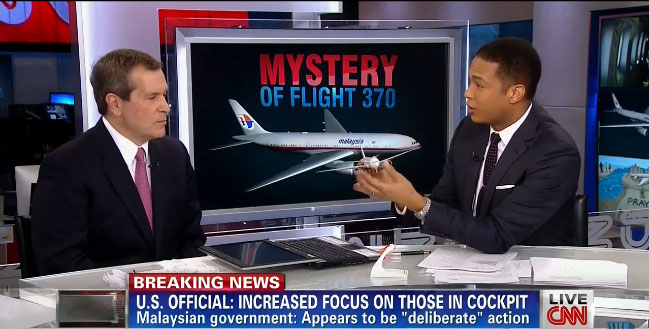Only Marginally More Unreal: Reconsidering CNN’s Coverage of Malaysia Airlines 370
Although the disappearance of the March 8 flight from Kuala Lumpur to Beijing was extraordinary, the initial coverage of it was not. All the major news outlets began with lavish reporting, becoming briefly and predictably singular in their focus on the missing plane. If the story had ended conventionally—perhaps with recovery of the plane, identification of a mechanical malfunction that had sent it fatally awry, or revelation of some incontrovertible evidence that the pilot or the crew had acted deliberately—the coverage would have found its way to denouement. But the story did not end conventionally, and in the absence of this, most popular media attention has merely drifted in other directions, without resolution. Updates on the search still merit passing mentions, but the biggest story about the missing plane has now become the meta-story of its coverage, and specifically CNN’s persistent and often journalistically questionable work.
While the criticisms of CNN’s approach to Malaysia Airlines 370 are by now familiar, I want to explore the possibility that CNN’s coverage is actually—albeit unintentionally—meaningful. With its reliance on speculation, dependence on simulation, and occasional swerves into absurdity, it indexes the incomprehensibility of this disaster, marked by the failures of so many systems that seemed to promise safety, visibility, and order. To be clear, I do not mean to exonerate CNN, which is rather unabashedly utilizing this as a ratings grab. Nonetheless, their coverage vividly captures the essence of this disaster.
Some measure of qualified guessing is expected, even necessary, in any coverage of an unfolding disaster; CNN’s coverage is distinguished by its continued recourse to hypothesizing, but also the amount of latitude it gives to conjecture, as when it reported, in a way that many found insufficiently incredulous, that some people believed zombies had hijacked the plane. Criticizing such reportage is important, surely, but also eclipses its significance, as CNN’s speculation starkly illuminates the enormous epistemological gap created by the plane. It also reflects the failure of the rational and technologized systems designed to track aircraft during flight or locate them afterward. The imagined world governed by those devices (organized into grids of latitudes and longitudes, synchronized time zones, and orderly networks of predictable flight paths) cannot countenance the possibility of something like this. But CNN’s coverage shows us how far we have strayed from that map.
This departure is amplified by the visual elements of its coverage. The now-infamous use of a toy plane as a prop surely risked trivializing the disaster; likewise its reliance on flight simulator cockpits and computer-generated images that hover around its “virtual studio.” Even as it spectacularizes the disaster, however, simulation also resonates uncannily with it. All the visual modes of searching have failed to locate the plane: satellite images, aerial surveillance, maps of ocean topography. The utterly perplexing and apparently absolute disappearance of the plane, whereby all that is solid does not melt into air but vanishes into the sea, is the sort of thing that we, with expectations that our most advanced machines will function perfectly and our acculturation to being monitored at all times, can scarcely imagine. In that context, a holographic plane is only marginally more unreal.
The only signature element of CNN’s coverage that has not yet been widely lampooned is its attention to the stories of bereaved families and friends, many of whom give interviews in which they profess hope that their loved one will be found alive. Stories like that of the daughter who has been devotedly tweeting her crew-member father, steeped in poignant absurdity, would not find much purchase in a more staid outlet. One man, Pralhad Shirsath, in an April 23 interview, asserted that the paucity and poor quality of the information from the Malaysian government indicates that they do not have enough “data” about what happened, and, by extension, to convince him that his wife is truly lost. Necessarily, the journalist pressed him, citing conclusive evidence about the fate of the plane, but the potential widower remains undaunted. CNN, by creating this universe that defies the conventions of journalism (and the sometimes cruel boundaries of common sense), has provided these mourners with a space where their bewildering grief might be articulated. Given the likelihood that it will be months, or years, or longer before the plane is found (if it is found at all), CNN’s lingering on the story mimics the looping returns of sadness in the perseverating endlessness of grief.
Although CNN’s vigil is often self-interested and carnivalesque, the clamor against it is problematic, too. It endeavors to sanitize our visual field by expunging the traces of the logically unknowable, the empirically invisible, and the affectively unpalatable in defense of all that they threaten to destabilize. To partake of CNN’s vision of the disaster is to acknowledge that it was, and remains, both tragic and incomprehensible, and to allow those two dimensions of the event to dictate the disorderly and unpredictable terms by which it appears.




